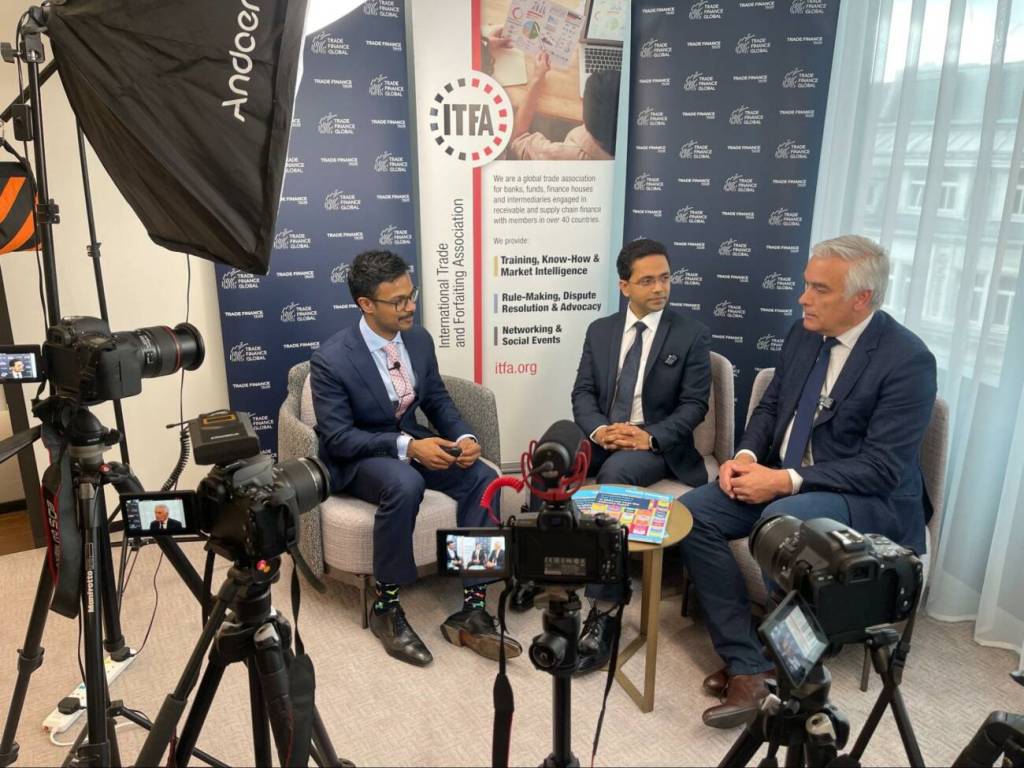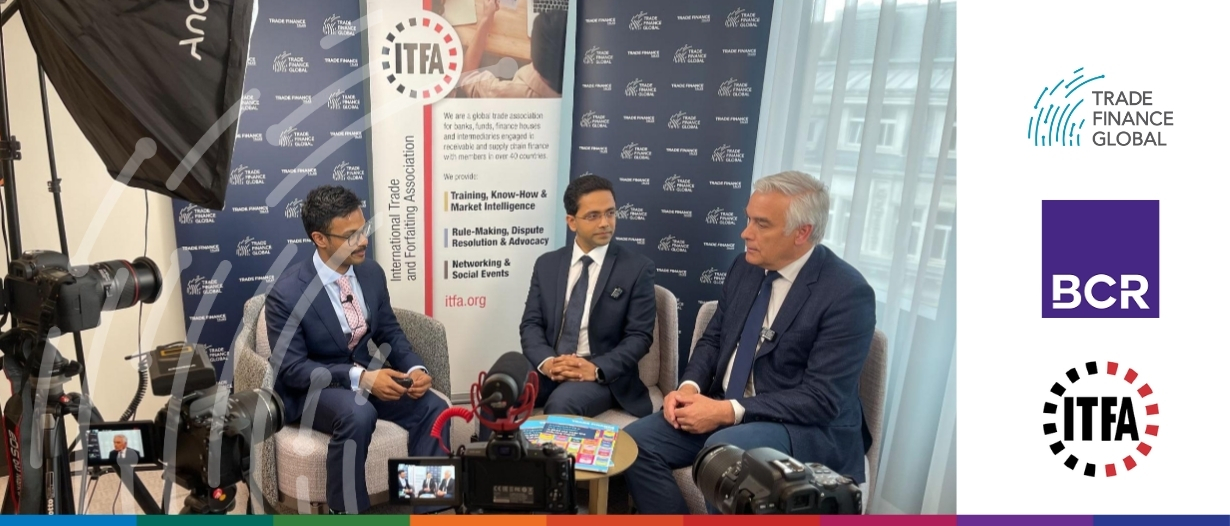Estimated reading time: 7 minutes
When it comes to international trade, digitalisation and legislation have a complex relationship. In 2021, the results of a TFG industry survey indicated that respondents viewed legal challenges as the key impediment to the trade, treasury & payments industry – more than standards, governance, or technology issues.
However, with the passage of the Electronic Trade Documents Act (ETDA) in the UK, things may be about to change. Nevertheless, the industry must remain realistic in terms of the outlook for a digital trade future.
At the second Trade and Investment Forum, organised by BCR in partnership with ITFA, TFG’s Deepesh Patel was joined by André Casterman, Chair of the Fintech Committee, ITFA, and Managing Director of Casterman Advisory, and Shobhit Singh, Head of Trade Finance, Concentrates, Trafigura, to explore what the next steps will be, how businesses can navigate these momentous shifts, and what the broader impacts on other fields may be.
Adoption of digital trade documents
There has been much talk about digital trade and accelerating the adoption of digital trade documents to grow opportunities when it comes to cross-border trade. Digital trade is critical to scale businesses and improve practices, reducing costs and accelerating processing.
ITFA’s Fintech Committee has focussed for the past five years on aligning policy developments with technology developments. This is because numerous technologies have been developed to digitise trade, but they have not scaled.
The 2017 United Nations Commission on International Trade Law (UNCITRAL) Model Law on Electronic Transferable Records (MLETR) legally enables the use, in electronic form, of transferable documents and instruments by complementing existing national substantive laws.
Singapore, Bahrain, and the Abu Dhabi Global Market were early adopters of the MLETR complaint laws, and the United States followed suit quickly. In the UK, the ETDA was enacted in September 2023 and stood out as a significant milestone in the digitalisation of trade.
Casterman said, “We are going to see more and more bank involvement in digitising trade flows in support of their corporate customers, in support of their SMEs, and in support of alternative lenders entering the space. So, across origination and distribution, we see most developments around the alignment of policy and technology for digital negotiable instruments on the origination side and for tokenisation and securitisation on the distribution side.”
Importance of digitalisation of trade documents
The digitalisation of trade documents is particularly important for the trade finance industry and, in general, the commodity industry due to the document-intensive nature of the sectors. Singh said, “Imagine the billions of trade documents flowing across the trade industry. You have issues with the documents or bills of lading being lost. They have cases where you have duplication of documents, then you have cases where you would have duplication of documents.”
Digitalising the documents not only cuts down on these issues but also decreases transaction times and lowers costs.
When the working capital cycle is lowered, this is accompanied by a reduction of the transaction cost itself due to the lowering of financing costs. There are also reductions in costs related to financing products on the trade side.

An important benefit for corporates in the commodity industry is to be able to reduce the usage of letters of indemnity, which can be either on the payment or discharge side.
Singh said, “It is very important because the people who are associated with the commodities industry know the contingent risk that lies with these letters of indemnity. Getting corporates like us to work with suppliers and receivers, making them understand why this is important, and getting them on board with making these trades digitally. And, of course, with the banks as well.”
Banks and digitalisation: Resistance to change?
Over the past decade, banks have faced issues relating to the misalignment between rules and technology. All of the technologies to digitise bills of lading or electronically signed documents are available. However, the legal environment has not been supportive.
This may be changing with the introduction of the ETDA, as well as similar initiatives in the pipeline in other regions. An enabling legal system/environment that recognises electronic transferable reports is key to more efficient trade transactions.
Nevertheless, Casterman said, “There is still, for banks, this resistance to change. Are my corporate customers really expecting this? What are the new risks involved in moving to digital options? Which digital options are acceptable?”
A key message, not only for regulators but also for banks is the need for increased transparency. Casterman said, “There is new value that can be added on top of digital records such as continuous transparency and visibility of the asset you are funding as a bank or as a credit insurer, or even as an asset manager in the distribution space. That is what this enhanced transparency should support – risk mitigation – and give greater comfort to the lenders that what they are financing still exists.”
Some regulators, such as Singapore, have gone even further in this regard and have used leveraged digitisation to combat double spending and double financing fraud.
Turning technological interoperability challenges into opportunities
With Trafigura being multi-banked, it can use several platforms from a commodity trading perspective, from a digital documentation perspective, and even from a lending and trade finance perspective.
However, with the ETDA coming into fruition, it could introduce more challenges for technology and interoperability.
This is a challenge that Trafigura continually faces. Working with over 150 banks, it is critical for technology to remain agnostic, ensuring easy interoperability. Due to the scale of their operations, corporates such as Trafigura cannot be dependent on a single platform.
Next step: Technology agnostic
Given the importance of interoperability, it is critical to encourage providers and technology platforms to be technology agnostic, ensuring they are interoperable with other providers.
In the digital trade space, the technology for this is available today. A digital negotiable instrument (DNI) can “navigate” from one party or platform to another. Casterman said, “We really need, and that is what we are doing through ITFA, to focus on scaling the market interoperating.”
Corporates want, and need to be technology agnostic and to be able to move from one platform to another when necessary. This requires interoperability with hundreds of banks and future lenders through various channels.
Casterman said, “It is not about forcing everyone into one platform which is, as I often say, a 20th century mindset…in the 21st century, we can interoperate; we have Web3 technologies, tokenisation technology, and we can make sure that one party in the chain is not forcing the second party in the chain to onboard the technology chosen by the first one…We are getting there. We have proof points that it can be achieved, and we hope that those who are still trying to lock in their communities are basically going to be forced to open up to interoperable practices.”
Early usage of digital trade instruments
Eight months since the enactment of the ETDA, industry leaders such as Trafigura have begun the digitalisation processes through the use of DNIs and digital trade documents due to the increases in efficiency, cost reductions, as well as increases in transaction speeds.
Trafigura has already worked with electronic bills of lading (eBLs) for close to 2 years, successfully reducing transaction costs and time.
Singh said, “We have been able to demonstrate with our suppliers and receivers that we can do trade transactions end-to-end; using electronic bills of lading and export letters of credit that are covered by e-UCP, allowing electronic bills of lading to be presented under the platform.”
This has led to decreasing the overall transaction time from 40-45 days to 20 days.
Breaking it down further, Singh said that now, the transfer of electronic bills can happen in a matter of seconds, and the process of documentation flow from the confirming bank to the issuing bank can be completed within one or two days.
The expedited transaction time is a game changer. But this is just the start, as the ETDA continues to be adopted, the industry will become better and more efficient.





























